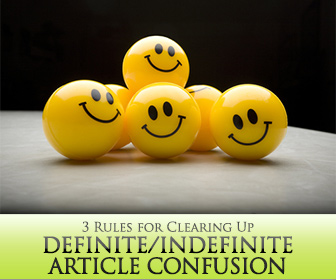A or the? The or some? Some or an? To put it simply, articles can be confusing.
ESL students often find that choosing the correct article in a given sentence is difficult. Perhaps it’s because their first language doesn’t use equivalents of a, the and some. Perhaps it is because English sometimes seems to be more exceptions than it is rules. Whatever the reason, every ESL teacher will have to teach articles at some point or another. Here are some tips for you and your students for keeping things straight when you face the question of definite or indefinite.

The Definite/Indefinite Article Confusion: 3 Rules
-
1
Are You New Around Here?
So much of whether the correct choice is the or a depends on context. Has a particular noun been introduced earlier in a conversation? Is this the first time the object or person is coming up? For objects that are new to the conversational context, a or an is usually the correct choice. These indefinite articles indicate that a general person, place or thing is being referenced. Take the following sentence for example. I saw a dog. Because I am using the indefinite article a, the reader can assume that I have not said anything about this dog earlier in my conversation. From this point forward, however, I will use a definite article for the same animal. The dog tried to chase me. If I am introducing a plural noun to the conversation, some is going to be the correct choice the first go around. This plural indefinite article should be used with the first introduction of a plural noun. I saw some dogs. As with singular nouns, any further reference to this plural noun should use the definite article the. The dogs tried to chase me. (The is appropriate for both singular and plural nouns.)
-
2
I’ve Never Met Anyone Like You
The second rule to keep in mind when teaching definite and indefinite articles is this. Unique objects always take a definite article. Most of the time, these unique nouns will also be proper nouns. Since they are names and usually start with capital letters, your students may have less trouble determining what article to use for unique nouns. However, not every unique noun is a proper noun. Take the following example. I looked at the moon last night. Though moon is not a proper noun and does not start with a capital letter, it is still a unique noun. The earth only has one moon, and so any reference to the moon should use a definite article. Other examples like this include the first lady, the president and the government.
Don’t forget that any superlative nouns are unique in that they are the one and only best. (The best ice-cream, the worst movie, etc.) Also, a noun might be unique because of its association with a previously mentioned noun in the sentence. Take the following example. I got a book on car repair. The cover was very interesting. Though many books exist as do many covers, this one cover is unique because it belongs to the book that I had already mentioned in the conversation.
-
3
Everyone Knows That
The final generalization when it comes to definite and indefinite article use comes into play with generalized statements or accepted truths. When a person is stating a general fact, the noun does not take any article. The noun usually appears in its plural form in these factual statements. Rain (noncount) falls from the sky. Raindrops (count) fall from the sky. No article is necessary. Similarly, generalized statements use the plural form without articles. I like cold weather (anytime). If one were to use an article in this sentence, it would change the meaning of the sentence. The speaker is no longer making a generalized statement or preference but is talking about the weather on a specific day. I like the cold weather (today).
We must conclude our discussion of indefinite and definite articles with both good and bad news.
The bad news is that English is full of exceptions and confusing choices. Your students will have to know and accept that at times they will make errors when it comes to choosing articles. The good news is that those mistakes can be few and far between when students understand and remember these three rules for choosing the correct article.
In what contexts are your students most often confused about definite and indefinite articles?
P.S. If you enjoyed this article, please help spread it by clicking one of those sharing buttons below. And if you are interested in more, you should follow our Facebook page where we share more about creative, non-boring ways to teach English.







